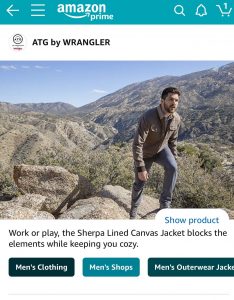What Are Amazon Posts?
Amazon Posts are a browse-and-discover experience specifically focused on brand shopping via curated posts. While only viewable on mobile, each image links to the featured product’s detail page for no-hassle purchases. As demonstrated in the Amazon posts examples below, the look and feel of Posts mimics Instagram’s format. This was intentional to make it feel like a familiar shopping experience.
Appearing in carousels at the bottom of PDPs, Posts are shoppable and increase product discoverability. Products are grouped together with related categories, similar to hashtags.
The Benefits of Amazon Posts
- Posts allow brands to share product-focused content in an interactive way. The longer a shopper stays on a page, the more likely he or she is to convert.
- Brands can view engagement metrics at https://posts.amazon.com to better understand what type of content resonates with customers. Data sheets, which can be downloaded there as well, are formatted to display viewable impressions, total engagement, click to detail page, clicks to brand feed, clicks to related feeds, clicks to show products, click to expand caption and engagement rate.
- Posts are currently free to use. However, Amazon often launches features as free and adds fees later on. Mindgruve urges its clients to proactively participate in the beta stages of many Amazon releases, which are ideal for testing.
- Amazon takes the guesswork out of where to place your Posts by automatically placing them in relevant feeds, products and competitor pages.
- There is no limit to the number of Posts you can create. More Posts mean more chances to populate different brand, category and related feeds. Ultimately, this increases brand visibility, awareness and sales.
Anatomy of a Post

- Profile Banner: Displays brand name and logo
- Follow Button: Customers that opt in can stay up to date and receive relevant notifications from the brand
- Custom Image: Demonstrates product features and benefits
- Show Product/Hide Product Icon: Customers can click for more information and to shop products directly
- Caption: Helps convey a brand tone, product features and benefits and even act as a call to action
- Category Tags: Amazon auto-tags posts with relevant product categories; shoppers can access a vertical feed of relevant posts
What to Include in Your Content
Begin by experimenting with various types of content to see how your customers engage. Repurpose imagery and written content from your social media channels to get started and tailor your strategy as data is collected. Amazon recommends posting as frequently as you post on your social media channels.
If the responsibility of posting falls to your social media team, you can grant permissions to new users from the User Management section of the Advertising Console (Vendors) or in the Manage Permissions section of Seller Central (Sellers).
Amazon Posts Best Practices and Content Specs
- Profile Name: This must be the registered name of your brand. It is case sensitive.
- Profile Logo: This must be the registered brand logo or social media icon that identifies your brand. It cannot be product or lifestyle images. It should be outputted as a 1×1 square image, no smaller than 640×640 pixels. Note that it will be automatically cropped and displayed in a circular format, so the full area of the image will not be displayed.
- Posts Image: These should be outputted in common display aspect ratios (e.g. 1×1, 16×9, 4×3). However, they will be cropped to a square image format (1×1) when displayed in carousels on detail pages.
- Caption Text: This can include up to 2,200 characters, however only the first two lines will be displayed by default. Note that the amount of content displayed will vary based on screen sizes. People will be able to tap on the caption to read the full text.
If you have additional questions about Amazon Posts, contact us.